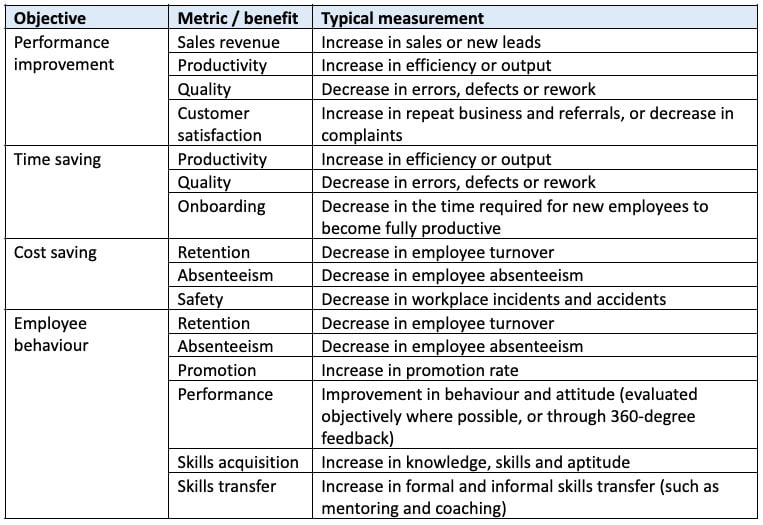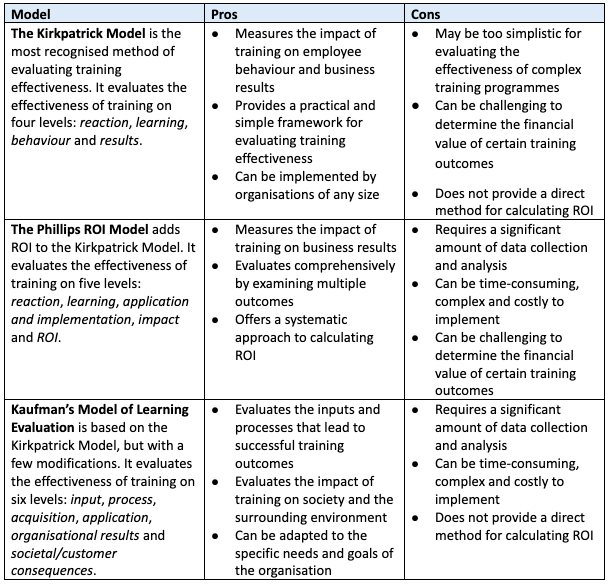Most organisations spend a significant amount of money on L&D, yet many HR professionals struggle to calculate the return on investment (ROI) of training. And the reason for this is clear - to calculate ROI, you need to allocate a financial value to the benefits of L&D, and this can be tricky.
So let’s start with the basics.
ROI formula
ROI is calculated using a simple formula:
Calculating the cost of an L&D intervention is usually simple – it is the total training cost, including:
- Direct costs such as the cost of developing the programme, facilitator fees, venue, transport, catering, training material, required software and licences.
- Indirect costs such as the time spent by the HR Department and other stakeholders to plan and implement the intervention, and the time employees spend away from work to attend the training.
On the other hand, the financial value of the benefits is more difficult to quantify. And since ROI is a financial metric, the benefits must be quantified.
Quantifying L&D benefits
Depending on the objectives of the L&D intervention, a wide range of potential benefits could be considered in the ROI calculation. Let’s consider how you could quantify them for the purposes of ROI.
If you’re wondering about evaluation metrics such as net promoter scores, training feedback surveys and knowledge assessments, these are not true metrics for calculating ROI.
Net promoter scores and feedback surveys measure an employee’s attitude towards the L&D intervention, and assessments measure knowledge gain. These are important, but they reveal only the short-term impact of training. Furthermore, calculating ROI requires hard data on the true impact of training on performance and behaviour, rather than information on training engagement and knowledge gain.
Effective learning and development should improve competencies, behaviour and attitude, and these gains take time to realise. ROI can therefore not be measured during or directly after the L&D intervention.
Calculating ROI
To accurately calculate the ROI in training, follow these steps:
- Define the objectives: Before initiating any L&D intervention, it is important to establish clear and measurable objectives. In other words, what impact must the training have on the organisation and/or employees? Examples of objectives are included in Column 1 of the table above.
- Identify the key metrics: Once the objectives have been established, identify the key metrics (or benefits) that will enable you to achieve these objectives. Examples of metrics are included in Column 2 of the table.
- Collect data: Accurate data collection is crucial for calculating ROI. Depending on the metrics you’ve selected, you’ll need to gather very specific data – before the L&D intervention, and then afterwards. For example, if employee promotion is a key metric, you’ll need data on the promotion rate before and sometime after the L&D intervention. Examples of the data you might need are included in Column 3 of the table. Also remember to carefully track the direct and indirect training costs.
- Calculate ROI: Calculate ROI using the formula.
Let’s consider an example.
Your objective is to improve business performance through an L&D intervention. The total cost of the intervention is R200,000. Six months after the intervention, you’ve gathered data on your metrics and you’re ready to calculate the ROI. The data is as follows:
In this example your return on investment in training is 233%. Another way of looking at it is that for every R1 you spent on training, you got R2,33 in value.
Optimising ROI
To make sure you’re getting the maximum value from your investment in training, follow these best practices:
- Conduct a needs analysis: Before designing or selecting an L&D intervention, identify the skills gaps, performance deficiencies and developmental needs in the organisation. By identifying the most critical areas for improvement, you’re more likely to identify the most suitable L&D intervention – and therefore increase your ROI.
- Set clear objectives: Establish clear and measurable objectives for each L&D intervention that are specific, realistic and tied to the desired objectives. This will help you design or select the most appropriate training, as well as know what benefits you’re expecting for your ROI calculation.
- Align training to career development: Help employees see the link between training and their advancement within the organisation. By aligning training initiatives to career paths, succession planning and talent management strategies, you can increase employee engagement, retention and ROI.
- Customise training programmes: Although there are a myriad of great off-the-shelf training programmes, customised training ensures that employees receive relevant and targeted content. This in turn leads to improved engagement and application, and ultimately a higher ROI.
- Engage managers and supervisors: Managers play a critical role in reinforcing and supporting the application of new skills and knowledge in the workplace. By engaging managers in pre-training discussions, setting expectations, and providing post-training support, you can enhance the transfer of learning and maximise ROI.
- Ensure continuous reinforcement: Training should not be a once-off event. To optimise ROI, incorporate continuous reinforcement strategies to ensure sustained learning and application. This can include follow-up courses, microlearning, and ongoing coaching or mentoring. Reinforcement activities keep skills fresh and reinforce learning over time, which increases long-term impact and ROI.
- Measure and evaluate effectiveness: Implement a robust evaluation framework to assess the effectiveness of L&D interventions. This includes measuring employee satisfaction, learning outcomes, behaviour change and business impact. Collect both qualitative and quantitative data through surveys, assessments, feedback sessions and performance metrics.
Regular evaluation helps identify areas of improvement and enables data-driven decision-making to optimise ROI. And remember that the calculation of ROI should not be a one-time exercise – it takes time to realise the full gains of training.
Beyond ROI
Calculating the financial return on investment in training is important from a business perspective, but it’s not always possible to quantify all training benefits. So while ROI is a significant indicator of training effectiveness, it’s not the only indicator. You may find it useful to explore the following alternative models:




